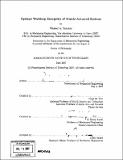| dc.contributor.advisor | Hugh M. Herr. | en_US |
| dc.contributor.author | Farahat, Waleed A. (Waleed Ahmed), 1975- | en_US |
| dc.contributor.other | Massachusetts Institute of Technology. Dept. of Mechanical Engineering. | en_US |
| dc.date.accessioned | 2008-11-10T19:55:18Z | |
| dc.date.available | 2008-11-10T19:55:18Z | |
| dc.date.copyright | 2007 | en_US |
| dc.date.issued | 2007 | en_US |
| dc.identifier.uri | http://hdl.handle.net/1721.1/39898 | |
| dc.description | Thesis (Ph. D.)--Massachusetts Institute of Technology, Dept. of Mechanical Engineering, 2007. | en_US |
| dc.description | Includes bibliographical references (p. 117-122). | en_US |
| dc.description.abstract | Skeletal muscles are the primary actuators that power, stabilize and control locomotive and functional motor tasks in biological systems. It is well known that coordinated action and co-activation of multiple muscles give rise to desirable effects such as enhanced postural and dynamic stability. In this thesis, we study the role of muscle co-activation from an energetics perspective: Are there situations in which antagonist co-activation leads to enhanced power generation, and if so, what is the underlying mechanism? The mechanical energetics of muscles are traditionally characterized in terms of workloop measures where muscles are activated against oscillating, zero-admittance motion sources. We extend these measures to more natural, "mid-range" admittance loads, actuated by multiple muscles. Specifically, we set up the problem of a second-order mechanical system driven by a pair of antagonist muscles. This is the simplest problem where the influences of load dynamics and muscle co-activation on the output energetics may be investigated. To enable experimentation, a muscle testing apparatus capable of real-time servo emulation of the load is developed and utilized for identification and workloop measurements. | en_US |
| dc.description.abstract | (cont.) Using this apparatus, an experimentally identified model predicting muscle contractile force is proposed. Experimental data shows that with a simple Weiner structure, the model accounts for 74% (sigma = 5.6%) of the variance in muscle force, that force dependence on contraction velocity is minimal, and that a bilinear approximation of the output nonlinearity is warranted. Based on this model we investigate what electrical stimulation input gives rise to maximal power transfer for a particular load. This question is cast in an optimal control framework. Necessary conditions for optimality are derived and methods for computing solutions are presented. Solutions demonstrate that the optimal stimulation frequencies must include the effects of muscle impedances, and that optimal co-activation levels are indeed modulated to enable a pair of muscles to produce more work synergistically rather than individually. Pilot experimental data supporting these notions is presented. Finally, we interpret these results in the context of the familiar engineering notion of impedance matching. These results shed new light on the role of antagonist co-activation from an energetics perspective. | en_US |
| dc.description.statementofresponsibility | by Walled A. Farahat. | en_US |
| dc.format.extent | 122 p. | en_US |
| dc.language.iso | eng | en_US |
| dc.publisher | Massachusetts Institute of Technology | en_US |
| dc.rights | M.I.T. theses are protected by
copyright. They may be viewed from this source for any purpose, but
reproduction or distribution in any format is prohibited without written
permission. See provided URL for inquiries about permission. | en_US |
| dc.rights.uri | http://dspace.mit.edu/handle/1721.1/7582 | en_US |
| dc.subject | Mechanical Engineering. | en_US |
| dc.title | Optimal workloop energetics of muscle-actuated systems | en_US |
| dc.type | Thesis | en_US |
| dc.description.degree | Ph.D. | en_US |
| dc.contributor.department | Massachusetts Institute of Technology. Department of Mechanical Engineering | en_US |
| dc.identifier.oclc | 182546073 | en_US |
